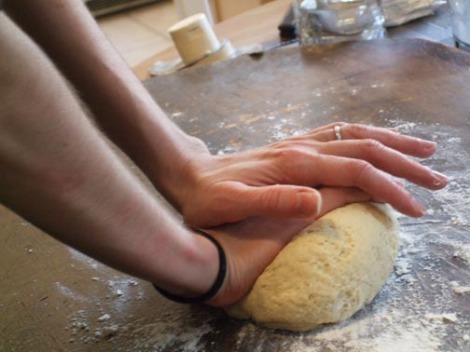I’m not sure if you remember, but last spring I wrote a rather pathetic post about my futile search for ramps. I had never tasted these coveted spring onions before, and visits to both my neighborhood and Union Square farmers’ markets were busts. Reading other bloggers rave on and on about ramps without knowing what was so special about them spun me into a ramp-related tizzy, and I remained so for the rest of 2009.
Well, I can finally relax. Over the weekend Jim came home with a bag of these slender greens from one of our local fruit and vegetable stands. With the help of this recipe, we took some whole-wheat dough out of the freezer and layered the ramps into a quick pizza bianca. With just olive oil, mozzarella, and a sprinkle of parmesan cheese acting as the base of the pie, Jim and I were able to revel in the pure, onion-like flavors of spring’s first sprouts.
While I’m happy to declare the end of my ramp-infused innocence, I’m not sure I understand the frenzy that begins when ramps hit the farmers’ market every year. Sure, they are only available for a few short weeks in early spring. And I understand that by the time ramps arrive everyone is sick of winter root vegetables and any sign of fresh spring vegetables is a welcome relief. But the fetishization of ramps seems to have reached a fever pitch in the past few years; David Kamp, the author of The United States of Arugula, agrees. He recently declared ramps the new arugula, in the way this formerly little known food product was once over celebrated and scrutinized back in the eighties. Last week Steve Cuozzo of the New York Post went further and said ramps are simply overrated. Of course, these are just a few dissenting voices in a sea of ramp enthusiasts, so I suppose I should keep my griping to a minimum.
What do you think, readers? Do ramps deserve the hype? Am I just a grump? Don’t answer that last question…
Recipe for Pizza with Ramps (adapted from The Kitchen Sink Recipes)
- 1 ball of your favorite pizza dough, white or whole-wheat
- salt
- 1 bunch of ramps, washed, with the bottoms trimmed
- cornmeal
- extra-virgin olive oil
- 8 oz. mozzarella cheese, grated
- a small amount of grated parmesan cheese (less than 1/4 cup)
- freshly ground black pepper
Preheat your oven to 450 degrees. (I use a pizza stone, so I am basing this recipe on this method.) Place your pizza stone in the oven so it can preheat.
While your pizza stone heats, put a medium size pot of salted water on the stove to boil. While you wait for the water to boil, roll out your pizza dough into a circle on a floured surface.
When the water is boiling, add the ramps. Let them boil for a minute or two, then drain and set aside.
Remove your pizza stone from the oven and sprinkle it with cornmeal. Place your circle of dough on a pizza peal. Brush it with olive oil. Sprinkle it with the mozzarella cheese. Place the ramps on top of the cheese so that they radiate out from the center of the pie. Sprinkle the pie with parmesan cheese. Drizzle a tablespoon of olive oil across the top of the pie. Season with black pepper. Carefully transfer the pie to your pizza stone.
Bake the pizza for about 10-15 minutes. Remove it from the oven when ready and top with another tablespoon of olive oil. Let it cool for about 5 minutes before cutting. Serves 3 to 4 people. Enjoy!















 Subscribe to the Choke
Subscribe to the Choke 
